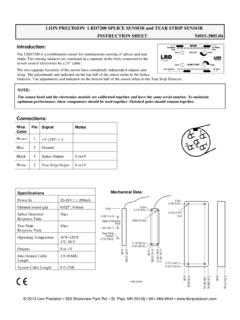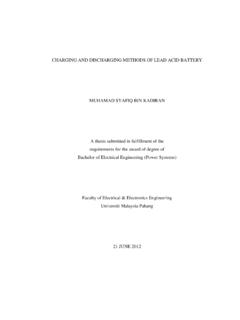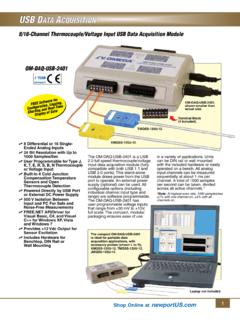Transcription of M015-9450.021 Elite Manual - Lion Precision
1 INSTRUCTION Manual Elite Series Capacitive Sensor Systems CPL190 CPL290 CPL490 MM190 TMP190 EN190 Lion Precision 563 Shoreview Park Road St. Paul, Minnesota 55126-7014 Telephone: 651-484-6544 Fax: 651-484-6824 Copyright 2015 All Rights Reserved Document 2 Table of Contents Approvals and Safety Considerations .. 3 Probe Tip Contact Caution .. 3 Helpful Technical Support Documents Online .. 3 CPL190/290 Sub-Nanometer Capacitive Displacement Sensor .. 4 Overview of Front Panel Controls, Indicators, and Connectors .. 5 Multiple Channel Measurements .. 5 CPL190/290 Specifications.
2 6 CPL490 Wide Bandwidth Picometer Capacitive Displacement Sensor .. 7 Overview of Front Panel Controls, Indicators, and Connectors .. 8 Multiple Channel Measurements .. 8 CPL490 Specifications .. 9 Changing CPL190/290/490 Bandwidth Settings .. 10 MM190 Meter and Function Module .. 11 MM190 Specifications .. 12 TMP190 Temperature Sensing and Encoder/Index Input Module .. 13 TMP190 Temperature Specifications1 .. 14 Encoder/Index Pulse Input .. 15 Elite Series 17 Power Specifications .. 17 EN191, EN192, EN193 Power Connector .. 18 External Power Supply .. 18 DAQ Connector Pinout .. 19 Mechanical Specifications: EN191, EN192, EN193.
3 20 Mechanical Specifications: EN196, EN198 .. 21 Accessories .. 22 Air-Bearing C-LVDT: Capacitive LVDT-Type Contact Sensor .. 22 3 Approvals and Safety Considerations The Elite Series is compliant with the following CE standards: Safety: EN 61010-1:2010 EMC: IEC 61326-1:2013, IEC 61326-2-3:2013 To maintain compliance with these standards, the following operating conditions must be maintained: All I/O connecting cables must be shielded and less than three meters in length AC power cables must be rated at a minimum of 250 V and 5 A AC power must be connected to a grounded mains outlet rated less than 20A Use the included CE approved power supply with 1-, 2-, and 3- slot enclosures.
4 If an alternative power supply is used, it must have equivalent CE certification and provide safety isolation from the mains according to IEC60950 or 61010. Sensors must not be attached to parts operating at hazardous voltages in excess of 33 VRMS or 70 VDC Use of the equipment in any other manner may impair its safety and EMI protections. Probe Tip Contact Caution The sensing tips of capacitive probes produce voltages as high as 70 Vrms. These are high frequency voltages with very low power so they pose no danger. Normally when the probe tip is touched, the probe stops functioning and voltage is reduced to near zero. But under certain circumstances, the voltage may cause a slight tingle or burning sensation, especially with the second generation probes used with the CPL490.
5 For maximum performance probe tips should remain free of oils or other contaminants. For these reasons, it is recommended the probe tips not be touched. Helpful Technical Support Documents Online Lion Precision s web site has a large selection of technical documents (TechNotes and Application Notes) in the Technical Library. These documents provide detailed descriptions of the operation and use of Lion Precision high-performance sensors. The Technical Library can be accessed at: Some of the titles include: Understanding Sensor Resolution Specifications and Effects on Performance Capacitive Sensor Theory of Operation Error Sources.
6 Probe/Target Angle Capacitive Sensors in Vacuum Capacitive Sensor Phasing and Ungrounded Targets Capacitive Probe Cabling Considerations Elite Series Phase/Amplitude Frequency Response Z-Height Measurement with Capacitive and Eddy-Current Sensors Thickness Measurement with Capacitive Sensors Glue Sensing with Capacitive Sensors 4 CPL190/290 Sub-Nanometer Capacitive Displacement Sensor The CPL190/290 Capacitive Sensor is a Precision , noncontact measurement device. The output voltage changes in direct linear proportion to changes in the gap between the probe and the target. The sensor is normally used to measure conductive targets, but it can also be used with nonconductive targets under the right conditions.
7 For more information about measuring nonconductors, visit the Technical Library at or call for assistance. The CPL190/290 works with most Standard Probes. Basic Operation The output voltage is accessed via the front panel BNC connector, or by a data acquisition system via the high-density connector on the rear of the enclosure. This connector can connect directly to National Instruments data acquisition products. See the enclosure section of this Manual for specifics on the system DAQ connector (page 19). As the gap between the probe and target changes, the output voltage will change accordingly. As the probe approaches the target, the output voltage will become more positive.
8 Note: Calibrated Range Near and Far lights (red) indicate that the probe is out of its calibrated range and the output is not guaranteed to be accurate even though the voltage may be in range and continue to change. Probes are calibrated to specific modules. With multiple channel systems, be sure the number on the probe cable (near the connector) matches the number on the module handle. The CPL290 provides low and high sensitivity calibrations for a single probe. Use the Sensitivity switch to select the desired sensitivity. Calibration detail is provided on calibration sheets shipped with the product. Noncontact sensors normally measure changes from a reference position.
9 Making a basic measurement 1. Connect probe to module 2. Set the target to a reference position or condition 3. Mount probe near target 4. Adjust the probe position until the Calibrated Range indicator is at center position 5. Use the Zero adjustments to adjust the output voltage to zero (optional) 6. As the probe/target gap changes, the output voltage will change accordingly Interpreting the output voltage The amount of change of the output voltage for a given change in the probe/target gap is called Sensitivity. The sensitivity of the sensor is listed on the calibration sheets which arrived with the sensor. Change in gap calculation: Gap Change = Voltage Change / Sensitivity For example: With a sensitivity of 1 V/2 m and a voltage change of 3 V, the gap change would be 6 m (3 ).
10 CPL190 ZERONEARCALIBR ATED RANG EOUTPUTPROBEFAROFFON 5 Overview of Front Panel Controls, Indicators, and Connectors Zero Adjust Adjusts the analog output voltage after the probe is initially positioned. Typically, the analog output voltage is adjusted to zero volts at range center. There is a coarse adjustment ( 10 VDC), the outer control, and a fine adjustment ( 1 VDC), the inner control. When the Zero switch is in the off position, the zero adjustment has no effect. Sensitivity (CPL290 Only) The CPL290 provides a high-sensitivity and a low-sensitivity calibration for one probe. Refer to the calibration sheets for specific calibration information.









